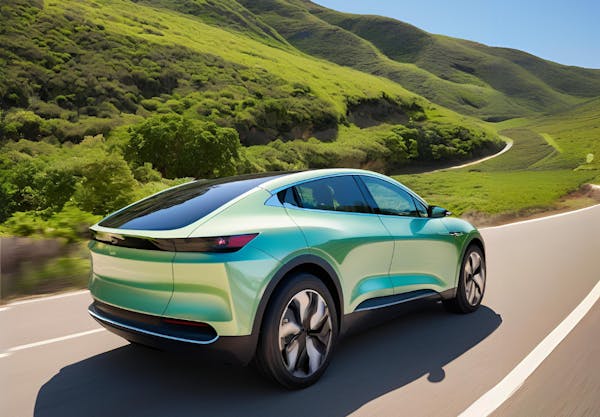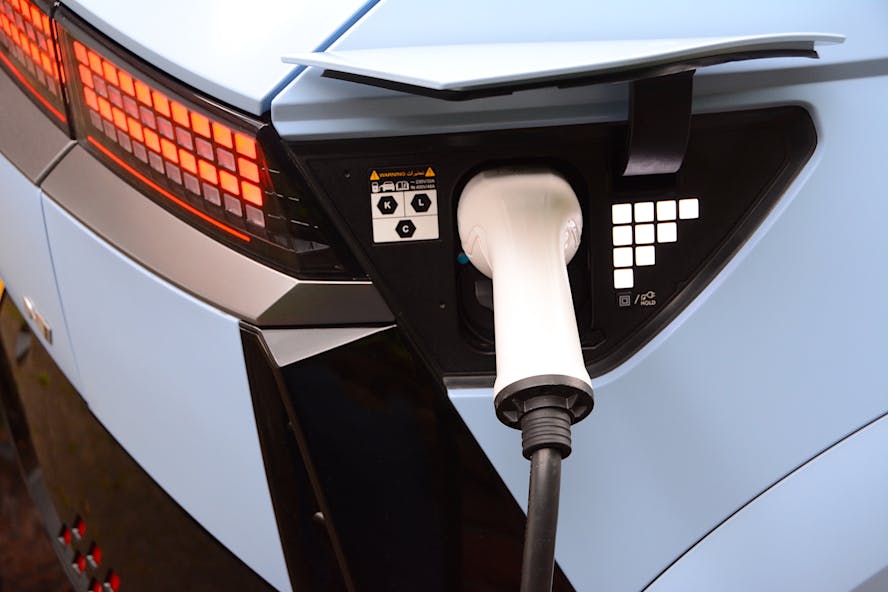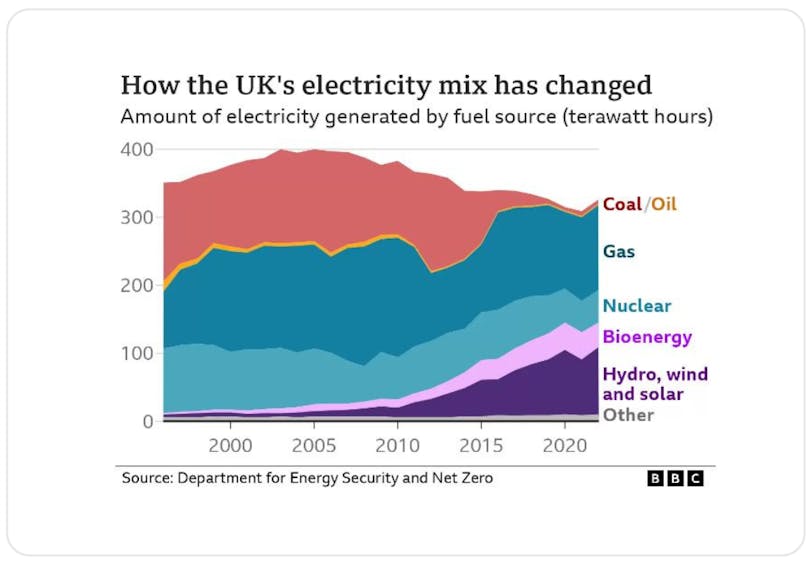How clean are electric cars?
Discover everything you need to know about EVs and emissions. Learn whether electric vehicles are carbon neutral and what the cleanest type of EV is.
Key highlights
-
Electric vehicles emit no greenhouse gasses directly as you drive.
-
EVs emit no other exhaust pollutants, like carbon monoxide and nitrogen oxides.
-
Electric vehicles do emit air pollutants as they brake, but likely at lower levels than petrol and diesel cars.
-
Greenhouse gasses are produced in generating the electricity used to charge EVs, but the National Grid is becoming cleaner every year.
-
Used electric vehicles are an even greener option as they have no embedded carbon footprint, and can help businesses seeking B-Corp certification.

Electric vehicles are more important than ever. The government has recognised that switching to electric vehicles (EVs) on our roads is vital for combating climate change and for reaching their Net Zero 2050 target. Sales of new diesel and petrol cars will even be phased out by 2035.
But how clean are electric cars, really? Can you make the switch to an EV in full confidence that you’re doing the right thing for the environment, or are electric cars too good to be true?
Here, we’ll explain just how clean electric vehicles are. We’ll look at whether electric cars are carbon neutral and whether you can recycle EV batteries, to give you an informed perspective on EVs.
EVs don’t emit greenhouse gasses directly
Diesel and petrol cars have combustion engines, meaning they burn carbon-rich fuel to power the car (both petrol and diesel are carbon-rich fuels made from crude oil). Combustion engine cars directly emit carbon dioxide (CO2) and other greenhouse gasses into the atmosphere as their engines run.
But as EVs are powered by rechargeable lithium-ion batteries, they don’t burn fuel when they’re running. This means electric vehicles emit no greenhouse gasses directly as you drive.

EVs produce lower levels of other pollutants
Whilst carbon dioxide emissions are important, they’re only part of the pollution picture. As petrol and diesel are burned in combustion engine cars, they also emit a range of other pollutants into the air. This includes carbon monoxide, nitrogen oxides, and carbon particulates.
These exhaust pollutants are a real problem and have contributed to poor levels of air quality in UK cities, especially in London. This kind of traffic pollution is a serious issue, as it can harm the natural environment and our health – especially in the young, old, and people with pre-existing health conditions. Poor air quality causes a huge number of deaths in the UK each year, between an estimated 28,000 and 36,000.
Again, as EVs don’t have combustion engines, electric vehicles don’t emit any pollutants via exhausts.
What about pollutants emitted by braking and from tyres?
Although EVs don’t emit any air pollutants from their engines, there have been news stories about pollutants emitted from brake discs and from tires as they wear down. There have even been stories in the news about how EVs will emit more pollution from brakes and tires than petrol and diesel cars, as EVs are typically heavier and might produce more wear.
Whilst there are currently no studies to support any of this, it’s likely that EVs produce less pollution from breaking than traditional cars do. Petrol and diesel cars use brake discs that deteriorate as they’re used. EVs also have brake discs, but they use their electric engines for braking too, reducing wear on brake discs and the pollution they cause.
When it comes to wear of tires, this is a problem that all vehicles face and will be one that needs to be addressed by better tire technology, not by sticking to combustion engine cars.
What about the indirect carbon emissions of electric vehicles?
When we’re judging how clean electric vehicles are, it really all comes down to how the electricity is generated that powers your electric car or van.
When you plug your EV in to charge it, you’re usually taking electricity from the National Grid. That electricity is generated by a range of sources, including coal-powered power stations, gas-fired power stations, nuclear power stations, wind turbines, biomass, solar, hydro, and imports from abroad. The exact mix of these sources can change on a daily basis.


If the electricity you’re using to charge your EV comes mostly from coal and gas, then your EV indirectly produces more greenhouse gasses and pollution. But if the electricity is generated more from environmentally-friendly sources – like wind, hydro, and solar – your EV will be cleaner.
You can’t control how the electricity is generated that powers your EV, unless you have home solar panels. But the good news is, the National Grid is becoming cleaner every year, making electric vehicles cleaner too.

Image source: https://www.bbc.co.uk/news/business-63976805
What about hydrogen cars?
Hydrogen cars are another clean alternative to diesel and petrol vehicles.
They’re powered by a hydrogen fuel cell rather than an electric battery. Unlike electric cars, which are charged, hydrogen cars are refuelled similarly to petrol vehicles. This refuelling process is quick and efficient, allowing you to get back on the road in just a few minutes.
Fuelling hydrogen cars in the UK presents some challenges due to the current state of infrastructure. With only a limited number of operational public hydrogen refuelling stations—mostly concentrated in and around London and a few other major cities—drivers may find it difficult to rely on hydrogen vehicles for long journeys or in areas without accessible refuelling options.
Like EVs, hydrogen cars don’t release greenhouse gasses directly, so are cleaner than diesel and petrol cars. However, it takes a lot of electricity to produce the hydrogen fuel they use – up to five times the amount of electricity needed to power an electric vehicle. If that electricity was produced 100% cleanly, then hydrogen cars would be equally as clean as electric cars, but that’s not yet the case in the UK.
Whilst hydrogen cars offer plenty of advantages – like quick refuelling and long ranges – there are currently limited refuelling stations and they’re not yet as environmentally friendly as electric cars when it comes to powering them.
Are electric car batteries recyclable?
One criticism of EVs is that their batteries can cause environmental damage if the lithium and cobalt-like materials they contain aren’t disposed of properly. But lithium-ion batteries can be recycled, and have been for some time.
BMW recycle and reuse their EV batteries
BMW have been re-using their EV batteries for energy storage since 2020. In Hamburg, a storage container holds 2,600 of these "second-life" battery modules, now used to stabilise the energy grid by storing excess power during low-demand periods and releasing it when demand surges. This process helps balance supply and demand, especially as renewable sources like wind and solar fluctuate.
BMW’s Leipzig plant employs a similar system with 700 i3 batteries, storing renewable energy to reduce production costs and enhance sustainability. Batteries can be used in this way for around 10 years. When fully depleted these batteries are then recycled, supporting BMW’s commitment to a circular energy economy.
Mercedes recover 96% of valuable materials from used EV batteries
More recently In 2024, Mercedes-Benz opened a groundbreaking battery recycling facility in Kuppenheim, Germany, which utilizes an innovative mechanical-hydrometallurgical process to recover over 96% of valuable materials from used EV batteries. This significant development highlights the growing emphasis on sustainability in the automotive industry and reflects a broader shift towards a circular economy.
By reclaiming essential materials like lithium, nickel, and cobalt, companies are taking proactive steps to minimize waste and reduce reliance on newly mined resources. Such advancements not only ensure a more eco-friendly approach to EV production but also demonstrate that recycling is vital for the future of sustainable mobility. For more details, check out our full article on Mercedes-Benz’s new battery recycling plant.

Mercedes-Benz EV battery recycling factory exterior in Kuppenheim, Germany
The benefit of a used electric vehicle
Buying or leasing a used EV can be even greener.
New electric vehicles will have an embedded carbon footprint caused by manufacturing them. Greenhouse gases will be produced as raw materials are extracted and transported, as the EVs are assembled and then shipped to dealerships. EVs can have a comparably high embedded carbon footprint due to the energy required to produce lithium-ion batteries.
But by opting for a used EV, you can avoid that embedded carbon footprint as the carbon has already been accounted for in the car’s initial purchase. If you buy or lease a used EV, no new vehicle needs to be produced.
Leasing used EVs can be particularly advantageous for businesses pursuing B-Corp certification by demonstrating a commitment to using the cleanest vehicles currently possible.
Go electric with DriveElectric
Electric vehicles are the future. They’ve been called out by the government as a key step in moving to a zero emissions economy by 2050.
Switching from diesel and petrol vehicles to EVs will demonstrate your business’s commitment to reducing its environmental impact, as well as lowering your operating costs.
Read more about electric cars and the environment, EVs versus petrol, diesel, and hybrid cars, and why electric cars are greener than hydrogen cars, with DriveElectric.
Find out how DriveElectric can help your business reap the benefits of going electric, and contact us to speak to one of our friendly business consultants.
FAQs
Published: Oct 2024